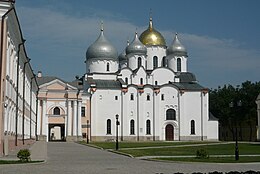
Novgorod Oblast is a federal subject of Russia. Its administrative center is the city of Veliky Novgorod. Some of the oldest Russian cities, including Veliky Novgorod and Staraya Russa, are located in the oblast. The historic monuments of Veliky Novgorod and surroundings have been declared a UNESCO World Heritage Site. Population: 583,387.
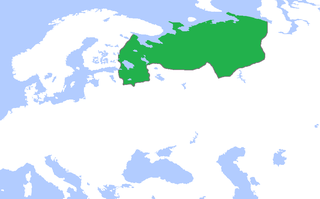
The Novgorod Republic was a medieval state that existed from the 12th to 15th centuries in northern Russia, stretching from the Gulf of Finland in the west to the northern Ural Mountains in the east. Its capital was the city of Novgorod. The republic prospered as the easternmost trading post of the Hanseatic League, and its people were much influenced by the culture of the Byzantines, with the Novgorod school of icon painting producing many fine works.

Kirillo-Belozersky Monastery, known in English as White LakeSt. Cyril's Monastery, is a Russian Orthodox monastery in Kirillov, Russia. It used to be the largest monastery and the strongest fortress in Northern Russia.

The architecture of Russia refers to the architecture of modern Russia as well as the architecture of both the original Kievan Rus', the Russian principalities, and Imperial Russia. Due to the geographical size of modern and Imperial Russia, it typically refers to architecture built in European Russia, as well as European influenced architecture in the conquered territories of the Empire.

The Pskov Republic was a medieval state in northern Russia. Originally a principality and then a part of the Novgorod Republic, Pskov became an independent republic in 1348. Its territory was roughly equivalent to modern-day Pskov Oblast. Its capital city was Pskov.

The architecture of Kievan Rus' comes from the medieval state of Kievan Rus' which incorporated parts of what is now modern Ukraine, Russia, and Belarus, and was centered on Kiev and Novgorod. Its architecture is the earliest period of Russian and Ukrainian architecture, using the foundations of Byzantine culture but with great use of innovations and architectural features. Most remains are Russian Orthodox churches or parts of the gates and fortifications of cities.
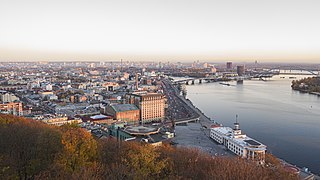
Podil or Podol or the Lower city is a historic neighborhood in Kyiv, the capital of Ukraine. It is located on a floodplain terrace over the Dnieper between the Kyiv Hills and the lower stream of Pochaina River. Podil is one of the oldest neighborhoods of Kyiv, and the birthplace of the city's trade, commerce and industry. After the Mongol invasion of Rus' and destruction of Kyiv, it served as a city center until the 19th century. Here the city administration (magistrate) and the main university were located, and later the city's port and shipyard were established here.
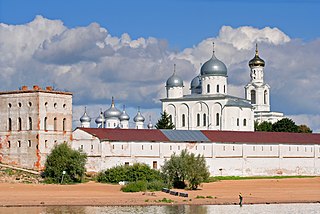
The St. George's (Yuriev) Monastery is usually cited as Russia's oldest monastery. It stands in 5 kilometers south of Novgorod on the left bank of the Volkhov River near where it flows out of Lake Ilmen. The monastery used to be the most important in the medieval Novgorod Republic. It is part of the World Heritage Site named Historic Monuments of Novgorod and Surroundings.

The Antoniev Monastery rivalled the Yuriev Monastery as the most important monastery of medieval Novgorod the Great. It stands along the right bank of the Volkhov River north of the city centre and forms part of the Historic Monuments of Novgorod and Surroundings, a World Heritage Site.
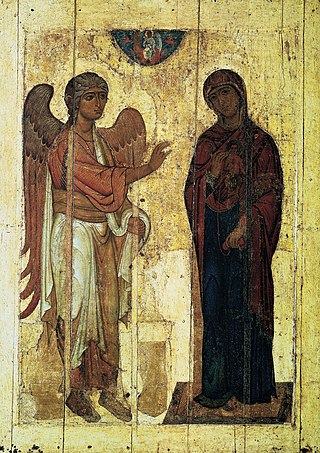
Annunciation of Ustyug is a Russian Annunciation icon, created in Novgorod in the 12th century, and one of the few icons which survived the Mongol invasion of Rus'. The Annunciation of Ustyug is currently held in the Tretyakov Gallery. The origins of the icon and the exact date of its creation are disputed.

Veliky Novgorod, also known simply as Novgorod (Новгород), is the largest city and administrative centre of Novgorod Oblast, Russia. It is one of the oldest cities in Russia, being first mentioned in the 9th century. The city lies along the Volkhov River just downstream from its outflow from Lake Ilmen and is situated on the M10 federal highway connecting Moscow and Saint Petersburg. UNESCO recognized Novgorod as a World Heritage Site in 1992. The city has a population of 224,286 (2021 Census).
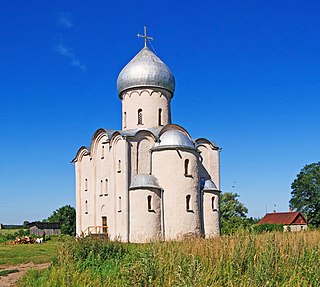
The Saviour Church on Nereditsa Hill near Novgorod is a 12th-century Orthodox church dedicated to the feast of the Saviour's Transfiguration.

Novgorodsky District is an administrative and municipal district (raion), one of the twenty-one in Novgorod Oblast, Russia. It is located in the southwest of the oblast and borders with Tosnensky District of Leningrad Oblast in the north, Chudovsky District in the northeast, Malovishersky District in the east, Krestetsky District in the southeast, Shimsky District in the southwest, Batetsky District in the west, and with Luzhsky District of Leningrad Oblast in the northwest. In the south, the district is limited by Lake Ilmen. The area of the district is 4,600 square kilometers (1,800 sq mi). Its administrative center is the city of Veliky Novgorod. Population: 57,673 (2010 Russian census); 58,622 ; 55,491 (1989 Soviet census). In terms of both area and population, this is the largest district in Novgorod Oblast.

Nifont was Archbishop of Novgorod from 1130 to 1156, the first prelate of Novgorod the Great to hold that title, though it appears the title was held personally and did not extend to the office until 1165. During his tenure, the prince of Novgorod was first dismissed and "shown the road," beginning Novgorod's period of independence in 1136 which was to last until 1478.

Church of St. Paraskevi in Veliky Novgorod is one of Russia's oldest churches, dating from 1207. The church is located at the city center, at the former Yaroslav's Court and the market square. It is currently a museum.
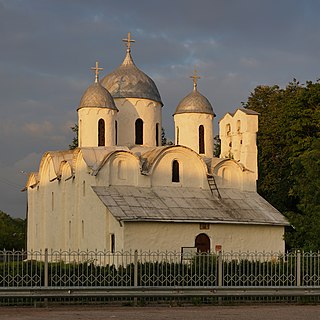
The Convent of Nativity of Saint John the Baptist is a former Russian Orthodox nunnery in Pskov. It is notable for the katholikon, one of Russia's oldest churches, dating from the first half of the 12th century. The church is located at the city center, on the left bank of the Velikaya River, in the Zavelichye quarter. It currently belongs to Krypetsky Monastery. It is the second oldest building in Pskov after the katholikon of the Mirozhsky Monastery and was designated an architectural monument of federal significance (#6010016003). The Cathedral of Ioann Predtecha is part of the Churches of the Pskov School of Architecture, which became an World Heritage Site in 2019.

Saint Nicholas Church on Lipno Island is a late 13th-century Russian Orthodox church sitting on a small island in the delta of the Msta River, 9 km south of Novgorod. Its design harks back to the Nativity Church on Peryn Island.
